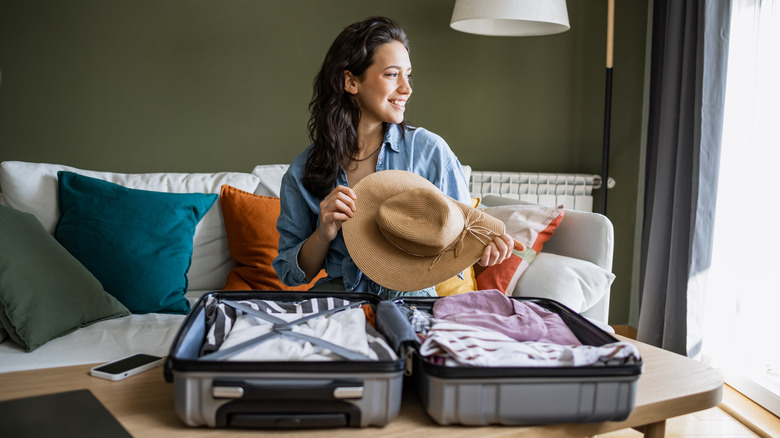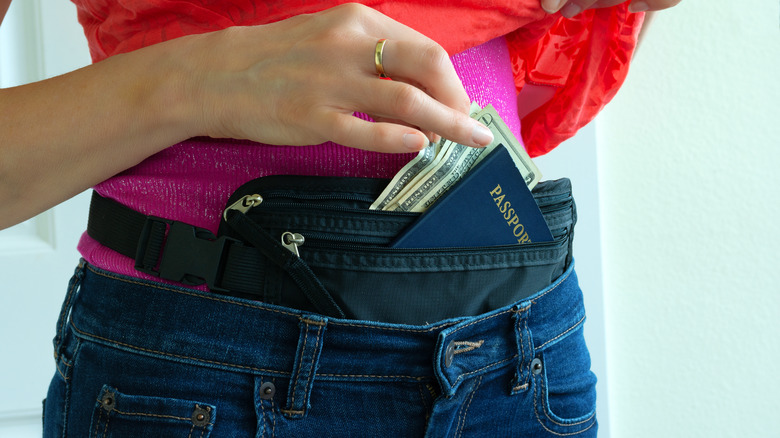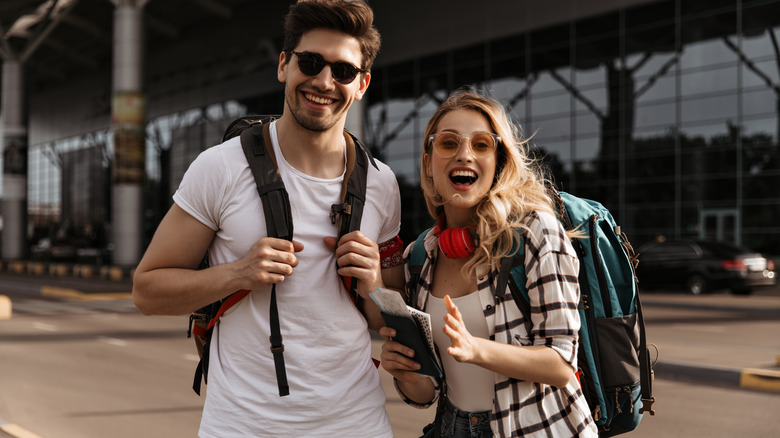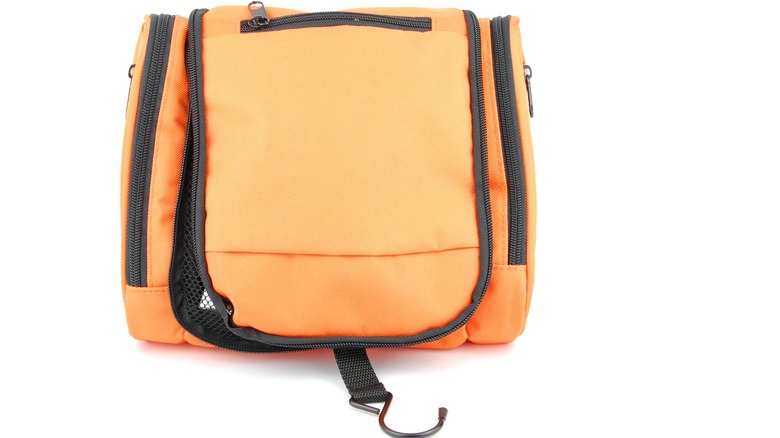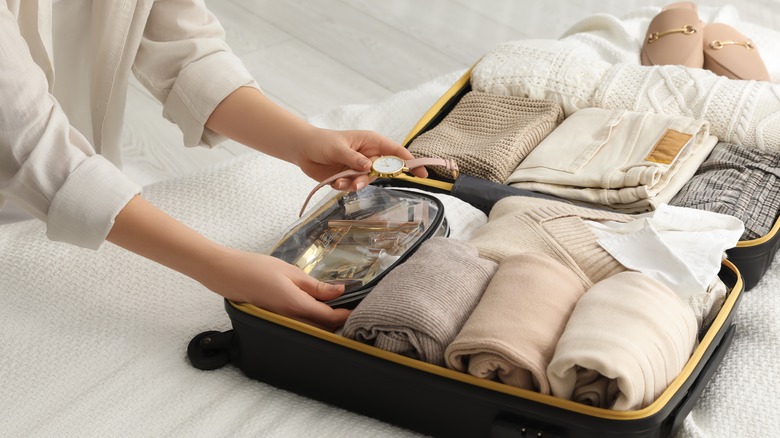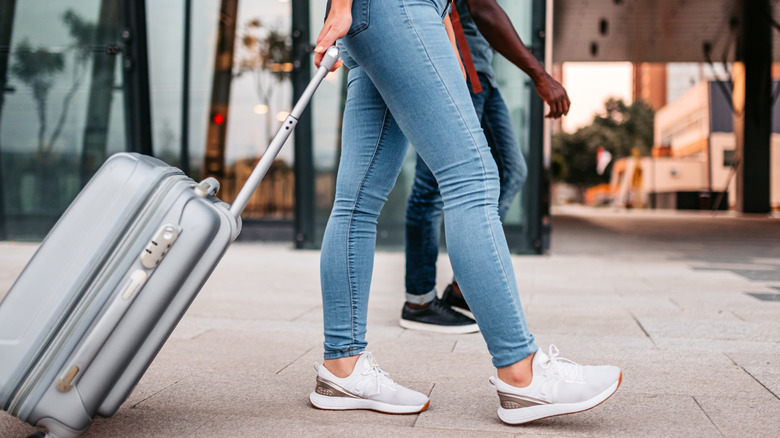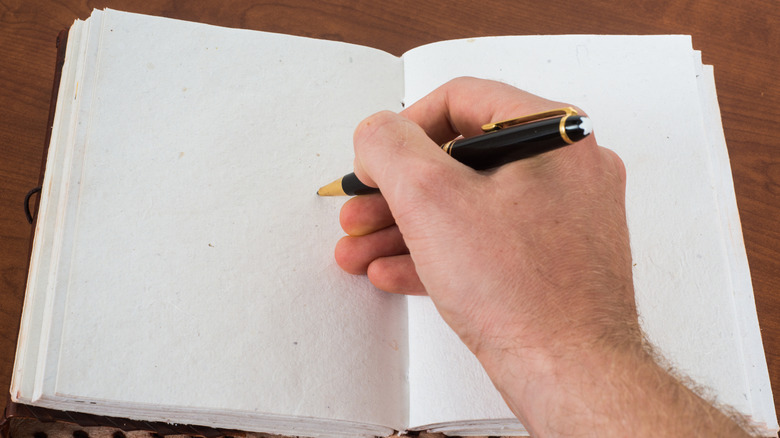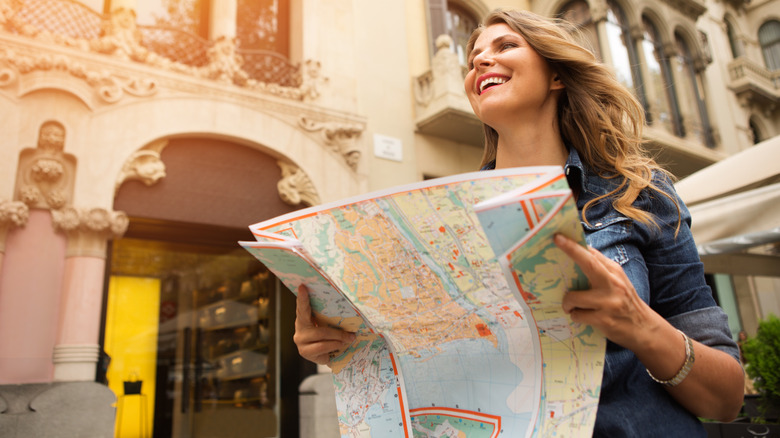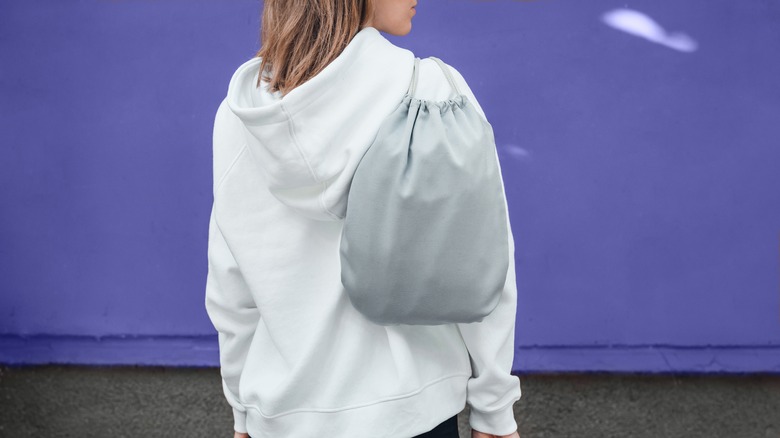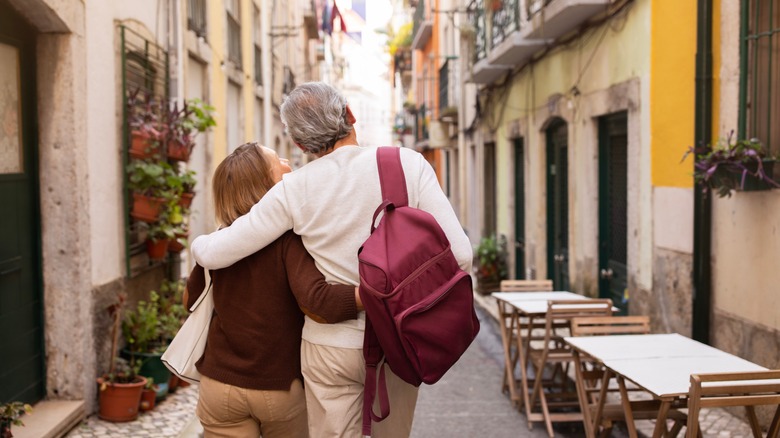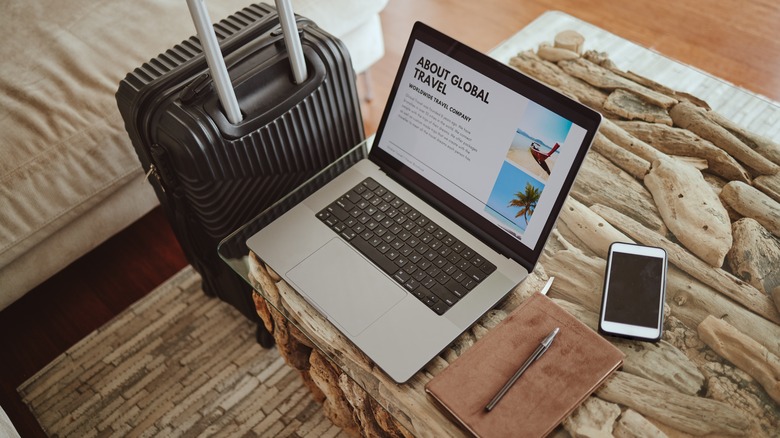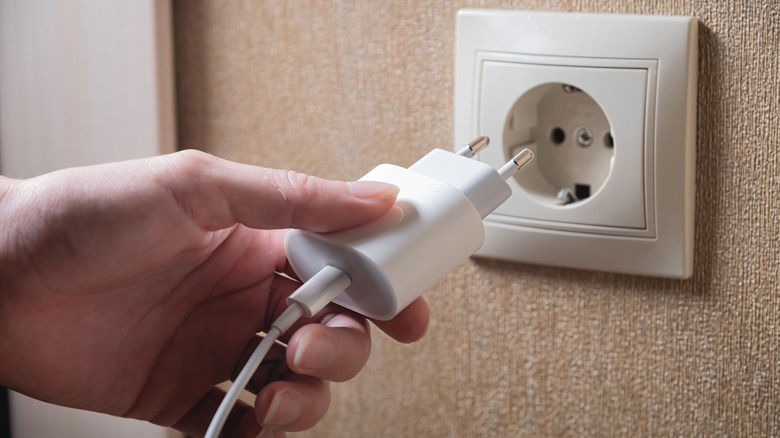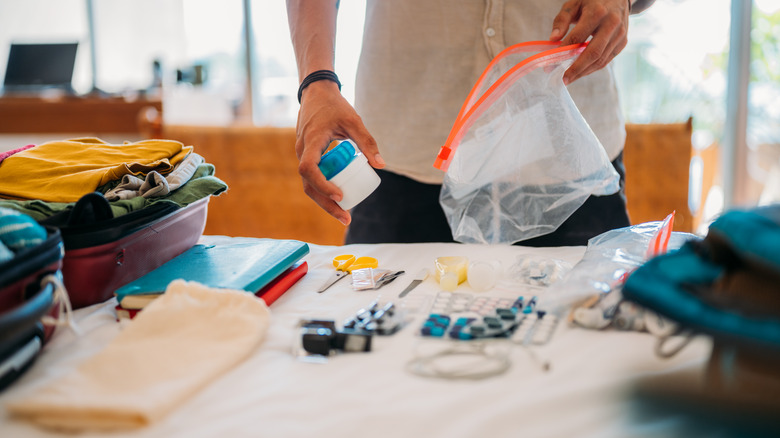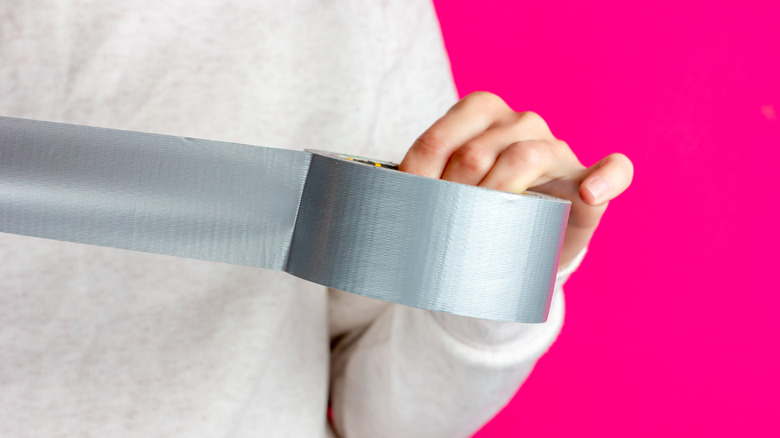Things Rick Steves Never Forgets To Pack For A Trip To Europe
For many people, traveling domestically across the United States can be a breeze, but going abroad to Europe is a different story. Thankfully, travel writer and television personality Rick Steves has shared some of his favorite tips when it comes to spending some time in Europe. From more practical picks like a money belt to out-of-the-box ideas like resealable plastic bags, Steves has a similar go-to packing routine for trips as short as two weeks and as long as three months.
The travel expert advises people to be wary that while there are certain things they should always bring, they also cannot have too many bags weighing them down. Steves gets into an in-depth conversation about the importance of "packing light" in several of his videos, and the first part of that plan is the type of bags people should be bringing. Of course, Steves also explains what should go into the bag –– including one pair of practical shoes, re-wearable clothing, and basic toiletries.
More than anything, Steves clarifies that while bringing certain necessities is important, travelers should prioritize being mobile, not overpacking for the worst-case scenarios, and asking if they'll use an item enough to justify bringing it. However, there are some items that Steves recommends all travelers should bring while spending some time in Europe. Keep reading to make sure you're bringing all of Rick Steves' must-haves for going to Europe.
Money belt
Even in the modern era of traveling, Steves still recommends bringing a money belt to prevent pickpocketing while in Europe. "More secure than a travel wallet, money belts are your key to peace of mind. I never travel without one," he wrote in a blog post. A tourist can place the money belt underneath your clothing and store most forms of payment and any other essential documents to have on you. Some things he suggests go inside include a passport, an ID, credit and/or debit card, cash, a vaccination card, and transportation tickets.
However, Steves notes that money belts only work when people wear and store them correctly, so make sure to properly tuck them back inside after each use and don't wear them as a fanny pack. Tourists can also carry some spare cash in a clothing pocket that's zippered if they'd like to use some cash for the day without getting out the money belt, but make sure it's a small enough amount you'd be okay to lose.
The travel pro recommends his Civita Money belt because it has a long elastic waistband, two zippered compartments, and even a lifetime guarantee. Some people can also use a neck pouch or a hidden pocket if they find the money belt uncomfortable.
Carry-on convertible suitcase backpack
If there's one thing Steves believes in, it's packing light, and if there's one thing Steves does not believe in, it's checking a bag for an international trip. "I absolutely never check a bag. These days, with all the chaos and frustration at airports, that's more important than ever. I generally wait to board till the very end, and I just always find a place to squish my bag up on top," he told Business Insider in August 2022.
Steves has two kinds of bags he recommends to his readers, depending on the form of traveling and what someone prefers. The first option is a convertible bag with strategically placed pockets and straps that easily transforms from a backpack to a suitcase without wheels. For people who prefer wheels, some options include a roller backpack with straps on the back or a traditional soft-sided suitcase with 360-degree spinner wheels.
Regardless of the option you choose, Steves emphasizes that you should feel comfortable carrying it or wheeling it around for a long time. He even suggests packing everything you need in your planned carry-on and walking around or running errands with it for about an hour so you know if it's mobile enough for you.
Hanging toiletry bag
When traveling with only a carry-on bag, it's crucial to only bring the things that you need, and this includes toiletries, according to Rick Steves. Steves suggests bringing a small to medium-sized hanging toiletry bag to pack inside your carry-on so guests can hang their bag in the bathroom rather than taking up counter space on the countertop.
As for what goes in the hanging toiletry bag, once again, Steves recommends bringing only the necessities. Travelers can start with what they need the most –– such as prescribed medications, a toothbrush, toothpaste, sunscreen, deodorant, and a hairbrush. He reminds his viewers and readers that hundreds of millions of Europeans live across the continent and get their toiletry and pharmaceutical needs from their own grocery stores and drugstores.
Most European hotels also offer tiny toiletries such as soap, shampoo, conditioner, and tissues. However, if you need any specific items, just make sure they fit traveling regulations, like liquids and gels being less than 3.4 ounces.
Layered clothing
Before someone even begins to start packing, Steves encourages travelers to vigilantly check their destination's climate and weather around the time they're going. This way, travelers don't even have to worry about bringing clothing they won't use. Depending on the time of year and location, Steves packs largely the same essential items.
For a warmer destination, Steves normally brings a light sweater, a light jacket, one pair of jeans, one lighter pair of long pants, shorts (that double as swimwear), a T-shirt, two or three short-sleeve shirts, two or three long-sleeve shirts, socks, and underwear. When he's visiting a colder destination, his wardrobe is pretty similar, except he swaps out a light jacket or sweater for heavier sweaters and coats. He may also skip the shorts, pack only one short-sleeve shirt and T-shirt, and add more long-sleeve shirts. He also acknowledges that people should bring as many undergarments as they feel comfortable with and reminds them most destinations have washers or dryers if needed.
For women, Steves includes many of the same staple items as the men's list, but there are some swaps, per a Packing List for Women guide created by Joan Robinson. Women can add a few wrinkle-resistant dresses or skirts instead of pairs of pants or shorts. If they want to stick to pants, Steves suggests bringing one pair of more casual pants and one that's slightly more formal. They can also bring a swimsuit if the climate calls for it and any additional undergarments.
One pair of well-broken-in sturdy walking shoes
More often than not, shoes are the culprit for the heaviest item in a carry-on bag, so one pair is best. Steves suggests bringing one pair of comfortable, well-broken-in walking shoes. Some examples include sneakers, tennis shoes, walking shoes, or hiking boots –– depending on your anticipated terrain. Before the trip, travelers can shop around to see what fits them best and works for where they're traveling. Steves suggests brands like Mephisto, Ecco, and Rieker for shoes that are both comfortable and dressier.
If you have the room and capability to bring another pair of shoes, try to bring another light pair suited for the environment –– like comfortable sandals or waterproof shoes. Steves has also pointed out that if you're staying in a hostel or sharing a bathroom, tourists should bring a pair of shower flip-flops. Regardless of the kind of shoe(s) someone chooses, Steves emphasizes that they should already be broken in so there won't be any blisters on day two.
Notebook, journal, and pen
Even in our everyday lives, we often find ourselves whipping out a pen and paper to jot down a note, communicate with someone, or journal our day. Steves recommends bringing a small notebook and keeping it in your day backpack for organizational, sentimental, and communication purposes. Travelers can also bring a journal, but if you're in a crunch, make do with a sturdy, pocket-sized notebook, such as a Moleskine.
"I'm fanatic about those little black notebooks," Steves told Business Insider in the same August 2022 interview. Of course, Steves also uses the small book to journal his travel adventures so he can remember events, reflect upon them, and pass on his words of wisdom later. While it's important to bring both a writing utensil and a writing pad, they should all be relatively small and easily fit in your everyday bag so they can't drag you down.
Maps and pages from guidebooks
While Steves prioritizes not packing for worst-case scenarios, he does explain that being prepared with information from maps and guidebooks is crucial. Even with the technology from smartphones and computers, it's possible phones can run out of battery, stop working for unknown reasons, or not have cellular service. Tourists can always buy a map of a certain area while out and about, or they can prepare maps by jotting down notes on them and planning the specific days they need to bring them.
For a similar reason, Steves recommends ripping out a few pages or chapters of guidebooks to bring in a backpack or back pocket. Steves explains that he'll bring a few pertinent chapters from guidebooks and staple them together or put them in a travel binder. Make sure to highlight certain sections and write up the pages so it's easier and faster to locate the information you're looking for in both the guidebook chapters and the maps. "I rip up my guidebook and staple together the chapters and either rubber band them together or put them in a Ziploc baggie. That's important," he explained to Business Insider.
Miscellaneous drawstring bag for non-daily essentials
In addition to a carry-on bag and an everyday backpack, Steves always brings a lightweight drawstring or tote bag that holds the "ten essentials that you'll never need," he jokingly said in a 2011 episode of Rick Steves Classroom Europe. Some of these items can include things like a small umbrella, a spot remover, a bag of wipes, a travel alarm, a small laundry bag, a sealed bag for wet clothes, and an extra money belt.
Steves also suggests putting any items you pick up along the way — especially any souvenirs and food goodies — in the bag so your day backpack doesn't get too heavy. The point of the drawstring or tote bag is to keep an organized suitcase while also not having to throw everything into the day bag and weigh it down. At the end of the trip, travelers can also opt to make this bag their personal item.
Day bag or light backpack
According to Steves, tourists should bring a light bag for their daily excursions while abroad. For most of his trips, Steves uses a practical backpack to include all of his daily necessities. He suggests using one with lightweight material, secure pockets, and comfortable straps."When I'm out and about, I need to have like a purse or a day bag or a briefcase or whatever you want to call it," Steves told Business Insider.
As for what goes inside the bag, Steves puts in all the things he needs for a day while traveling, so he doesn't have to make a different bag for him for each day of traveling. Steves recommends including a light sweater, a camera, pages from a guidebook, maps, a notebook, a pen, a water bottle, Ziploc bags, and a phone charger. Travelers should already have a secure money belt on them, but if they're carrying anything else of value in their backpack, Steves recommends using a tiny lock to keep the zippers closed.
Laptop and smartphone
Before leaving for any vacation, travelers should ensure they have their wallets with the necessary documents. It almost goes without saying, but a smartphone is essential. A smartphone can lessen your packing list and act as your camera, GPS, compass, and alarm clock. It can also serve as a supplemental tool specifically for traveling.
Tourists can download apps for transportation, translations, airlines, and city guides to ensure a smooth traveling experience. Many countries in Europe even accept Apple Pay with an iPhone, so make sure to set that up beforehand for contactless payments. Before leaving, check out your cellular data plan to determine how much data you can use for things like email, browsing the internet, and making calls.
Travelers will most likely be using their smartphones for daily travel, but Steves reminds people to bring a laptop if they're doing anything for work and place it in the designated pocket in their carry-on bag. In addition to his phone and laptop, Steves has also stated that he "never" travels without his noise-canceling headphones.
Chargers
To be able to fully utilize your technologies, you should always bring the correct charging cords and ports. First of all, there are various cables for different kinds of smartphones, as well as different ones for computers. Remember to also bring the cables for any other technologies you're bringing –– such as cameras, digital reading devices, headphones, and more.
It's also crucial that tourists bring the correct plug since the American adaptor won't work in Europe. Travelers will need one of two European adapters depending on where they're visiting. In the United Kingdom, visitors must have an adapter with three prongs in a triangle formation. For the rest of Europe, the adaptor, aka the Euro Plug, will have two circular prongs on each end. There are several options for each plug available for purchase online, and some of them can even convert the European plug into an American one. Flying across the ocean only to find you can't charge your phone is no fun, after all.
Different forms of payment
Similar to chargers, the form of currency varies across Europe, from the United Kingdom to Eastern Europe and everywhere in between. In the U.K., people pay with pounds and pence, while many of the European countries use the euro. Steves recommends that tourists should grab some cash in the local currency, but he encourages people to wait until they arrive at their destination and then get cash because of better exchange rates. From there, he still discourages people from exchanging U.S. dollars for European cash because many places add a conversion fee. Instead, try to withdraw cash directly from an ATM. While it's good to know approximate currency conversions, he assures tourists to not get too stressed out about it.
In order to get cash, tourists will need an ATM card, so it's crucial to bring at least one and know the correct PIN. There are also several credit cards to earn points from traveling and eating abroad, so people can research the best options and bring a credit card, as well. Finally, even though Steves discourages exchanging U.S. dollars for European currency, he suggests bringing a small stash of American cash just in case of an emergency.
Ziploc bags
Steves swears by bringing Ziploc bags or other sealable plastic baggies in different sizes. "Ziploc baggies are a godsend ... [they] are really handy on the road," he told Business Insider. Steves has explained that the baggies often come in bulk packs, so it's not ideal to buy them on the road or to bring a whole pack when you only need a few for the whole trip.
Tourists can use resealable baggies for a slew of reasons –– including packing food, carrying a wet swimsuit, transporting wet clothing, ensuring toiletries don't spill, and even storing a smartphone while doing water activities or hanging out on the beach. Basically, you never know what you need it for until you need it. Steves reminds his readers to pack a variety of different sizes of baggies –– two-gallon, gallon, quart, sandwich, and snack sizes –– so they won't get stuck in a situation with a bag too small or too big.
Tape
Believe it or not, one of the things Steves never leaves without is some form of sturdy tape. Strong tape — like duct tape or black electrical tape — can "work miracles as a temporary fix," he wrote on his packing list blog. He suggests only bringing a small spool that totals less than a foot.
Travelers can use tape for things like patching over a hole, attaching a plug to its adaptor, fixing a shoe, and even rolling off hairs from clothing. If people don't have room to pack a full-size roll, there are now duct tapes that come in flat layers rather than the traditional rolling round form.
To be even more prepared, tourists can pre-cut some strips of tape and scatter them throughout their carry-on bag, miscellaneous bag, and light day bag. That way, even if they're traveling on a plane and can only reach one of the bags, they can still easily find a piece of tape.
